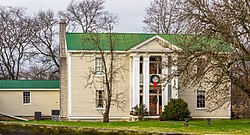Jordan, William B., Farm | |
 | |
| Nearest city | Eagleville, Tennessee |
|---|---|
| Area | 117 acres (47 ha) |
| Built | 1850 |
| Architectural style | Greek Revival, Italianate, I-house |
| NRHP reference No. | 92000825 [1] |
| Added to NRHP | July 13, 1992 |
The William B. Jordan Farm is a historic farmhouse in Eagleville, Tennessee, U.S..
The farmhouse was built for William B. Jordan, a farmer who owned slaves, from 1847 to 1850. [2] It was designed as an I-house in the Italianate and Greek Revival architectural styles. [2] Moreover, "according to local folklore", the portico was designed by "traveling Italian craftsmen." [3] However, Tennessee State Historian Carroll Van West believes there is no evidence this was the case. [3]
The house has been listed on the National Register of Historic Places since July 13, 1992. [4]
References
- ^ "National Register Information System". National Register of Historic Places. National Park Service. July 9, 2010.
- ^ a b "National Register of Historic Places Continuation Sheet: William B. Jordan Farm". National Park Service. United States Department of the Interior. Retrieved March 30, 2018.
- ^ a b Sasser, Gray (July 8, 1992). "Local sites get national recognition". The Tennessean. p. 83. Retrieved March 30, 2018 – via Newspapers.com.
- ^ "Jordan, William B., Farm". National Park Service. United States Department of the Interior. Retrieved March 30, 2018.
Jordan, William B., Farm | |
 | |
| Nearest city | Eagleville, Tennessee |
|---|---|
| Area | 117 acres (47 ha) |
| Built | 1850 |
| Architectural style | Greek Revival, Italianate, I-house |
| NRHP reference No. | 92000825 [1] |
| Added to NRHP | July 13, 1992 |
The William B. Jordan Farm is a historic farmhouse in Eagleville, Tennessee, U.S..
The farmhouse was built for William B. Jordan, a farmer who owned slaves, from 1847 to 1850. [2] It was designed as an I-house in the Italianate and Greek Revival architectural styles. [2] Moreover, "according to local folklore", the portico was designed by "traveling Italian craftsmen." [3] However, Tennessee State Historian Carroll Van West believes there is no evidence this was the case. [3]
The house has been listed on the National Register of Historic Places since July 13, 1992. [4]
References
- ^ "National Register Information System". National Register of Historic Places. National Park Service. July 9, 2010.
- ^ a b "National Register of Historic Places Continuation Sheet: William B. Jordan Farm". National Park Service. United States Department of the Interior. Retrieved March 30, 2018.
- ^ a b Sasser, Gray (July 8, 1992). "Local sites get national recognition". The Tennessean. p. 83. Retrieved March 30, 2018 – via Newspapers.com.
- ^ "Jordan, William B., Farm". National Park Service. United States Department of the Interior. Retrieved March 30, 2018.